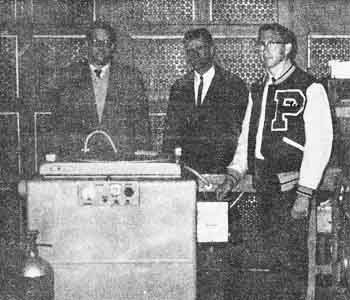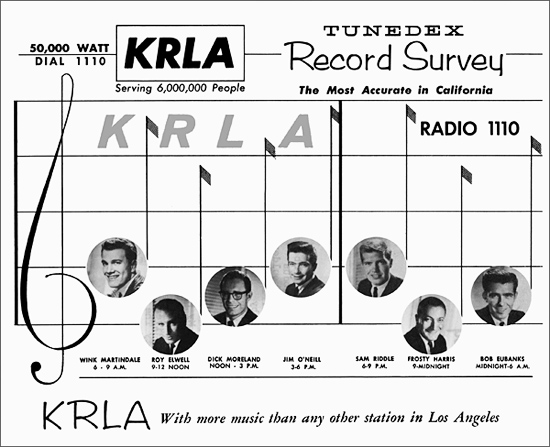KRLA and the 1965 laser moon bounce
Mister Moonlight!
8.20.14
In the nineteen-sixties laser beams were making big news. The July 11, 1960 issue of Broadcasting carried a story about Dr. Theodore H. Maiman, a Hughes Aircraft scientist, who described a "light amplifier" that could be used for radio, television, and miltary communication, and perhaps even surgery. It was called a laser: "light amplification by stimulated emission of radiation."
By 1964 high school students were developing their own laser technology for science fairs. Even James Bond was threatened with a laser beam, which the nefarious Goldfinger intended to use to cut Bond in half. Ouch!
Up in Palmdale, California, Mark Q. Morgan was experimenting with lasers too. He was a high school senior and president of the Palmdale High science club. Working with his chemistry and electronics teacher plus a schoolmate, Morgan built his own laser.
The body of the device was made from an old ice-cream vending machine, the control console from a medicine cabinet. Fondly called "Little Herman," it could demonstrate the power of the laser beam by burning holes in wood, plastic, and steel.
The March 2, 1965 edition of the Antelope Valley Daily Ledger-Gazette had a detailed story about Mark's experiment and word filtered out to the Los Angeles Basin. KRLA deejay Casey Kasem read about it and a lightbulb went on over his head, so to speak. Why not use Mark's laser as a publicity stunt of some kind? Could it be done?

Casey contacted Mark Morgan who explained that he was developing a continuous wave transceiving radio station designed to catapult a radio signal by laser to the moon and back. Casey thought that was a nifty idea. He prepared a tape to broadcast and Mark used it to bounce up to the crater Archimedes in the sea of Imbrium (if you'd like to use Google Maps to see where that is, feel free).
KRLA patched Mark's signal into their broadcast with a telephone line and he returned the signal from the bounce the same way. Considering the half-million mile round-trip journey through space, signal fidelity was remarkably good, although Mark noted that the signal decayed a bit toward the end of the broadcast due to the rotation angle of the earth to the moon.
"It was a real nail biter for me," Mark recalls today. "The equatorial mount guiding my receiver lost its azimuth drive motor and I had to guide it by hand with a cross hair. I thought the whole world was watching, I guess there might have been a few thousand people listening."
The Antelope Valley Press reported that twenty-five people watched the moon-bounce broadcast in Mark's back yard in Palmdale "as the moon slowly crept over the horizon on that dark, starlit night."
The Los Angeles Herald-Examiner wrote an enthusiastic review of the event, which they reported started at "10 seconds after 12:29a.m." on August 20, 1965. The broadcast, said the Herald-Examiner, included "a talk by a station official, the national anthem -- and a Beatle record." Mark told the Herald-Examiner that although scientists had previously transmitted laser beams to the moon and back, this was likely the first time a beam had been transmitted for a sustained period of time.
As a public relations event of note it was undeniably a triumph. No other Los Angeles radio station had done anything like it -- broadcasting the voice of one of its star personalities to the moon, not to mention the hit record of that week, the newly-released Beatles' single "Help!" plus, for good measure, the top female singing group in the world, The Supremes, with their 1964 single "Nothing But Heartaches."
International shortwave radio stations had developed standards for punctuating their broadcasts with the national anthem of their respective countries, so "The Star Spangled Banner" was hardly out of place. The announcer just before Casey Kasem remains unidentified. If you recognize his voice, perhaps you'd be willing to share with us?
Other than the L.A. Times, the Herald-Examiner, and several Antelope Valley newspapers, no other trace of this momentous event remains. Curiously the KRLA Beat didn't cover it. An event three days before the first-ever Beatles concert in Los Angeles, which KRLA engineered...surely there was room for a little self-promotion for celebrating another radio "first"? But no. For whatever reason, KRLA's own newspaper said not a word about this scientific feat.
It's possible that someone in the KRLA upper echelon put the kibosh on more publicity. After all, the experiment earned the wrath of the FCC, who heard about the broadcast from ships at sea intercepting the moon-bounce radio signals. KRLA had had long-running issues with their broadcast license renewal due to some contest and station log irregularities in 1960. What started out as a good idea may have resulted in KRLA having second thoughts about promoting their exclusive broadcast to space and back, the better to stay on the good side of the FCC. We'll never know for sure.
But now, forty-nine years to the day of its first broadcast, we want to share it with the world again.
Thanks to Mark Q. Morgan, who engineered the event and retained a tape of the broadcast, and to Timmy as well as Bruce Dumes for helping us add this historic aircheck to the collection.
KRLA moon bounce 1965Original KRLA airchecks online
Now!
We have a nice collection of airchecks -- recordings captured by listeners and engineers -- online at the link above right here as well.
Travel back in time and hear what KRLA sounded like during its golden era.
If you have any airchecks in your own collection that you'd like to share, we'd be happy to host them here. Just contact the webmaster to get started.
Thanks for your interest in KRLA, the KRLA Beat, and the sounds of the past!